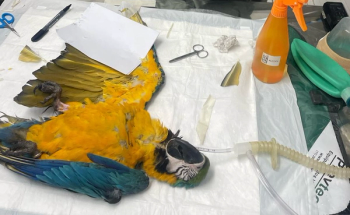
Just Ask the Expert: Why does this duck have a foamy eye?
Dr. Juliet Gionfriddo helps find the cause of Lucky Duck's eye matter.
Dr. Gionfriddo welcomes ophthalmology questions from veterinarians and veterinary technicians.
A Good Samaritan rescued Lucky Ducky. The duck has undergone treatment for egg binding and is making a good recovery. But seven days ago, she developed white foamlike bubbles in her right medial canthus. Is this discharge normal? If not, how do we treat this?
Lucky Ducky on presentation.
A. This duck has a condition known in lay terms as foamy eye or bubble eye. It is generally not indicative of an eye disease but rather an upper respiratory one, and affected ducks sometimes sneeze as well. Occasionally, this discharge can indicate a blocked tear duct. The discharge and respiratory problem may be self-limiting or, if relatively severe, could signify the need for a diagnostic work-up and subsequent treatment.
The underlying respiratory infection is often bacterial in origin, so swabs for bacterial culture and antimicrobial sensitivity testing should be taken. Bacterial diseases in ducks that have a respiratory component include pasteurellosis and, possibly, bordetellosis. Although more difficult to diagnose, viral infections (paramyxovirus and adenovirus) may also cause this upper respiratory sign.
Dr. Juliet Gionfriddo
Treatment of respiratory disease involves administering systemic antibiotics. Oxytetracycline is often used by bird owners because it is available in feed stores and is relatively inexpensive. Enrofloxacin is effective in many ducks with bacterial respiratory infections,1 but the drug is prohibited from use in poultry (chickens, and turkeys) in the United States. Therefore, be cautious when using antibiotics in ducks destined for consumption.
If you rule out an upper respiratory disease and suspect a nasolacrimal duct blockage, you can flush the duct with saline solution. This would need to be done with the duck under general anesthesia, and the duct should be flushed from the larger slitlike upper punctum toward the nasal cavity.
Juliet R. Gionfriddo, DVM, MS, DACVO
Department of Clinical Sciences
College of Veterinary Medicine and Biomedical Sciences
Colorado State University
Fort Collins, CO 80523
ACKNOWLEDGMENTS
Dr. Gionfriddo would like to thank Kristy L. Pabilonia, DVM, DACVM, an avian disease diagnostic veterinarian at Colorado State University's College of Veterinary Medicine and Biomedical Sciences, for her assistance in providing this answer.
REFERENCE
1. Pabilonia KL. College of Veterinary Medicine and Biomedical Sciences, College of Veterinary Medicine, Fort Collins, Colo: Personal communication, 2011.
Newsletter
From exam room tips to practice management insights, get trusted veterinary news delivered straight to your inbox—subscribe to dvm360.






